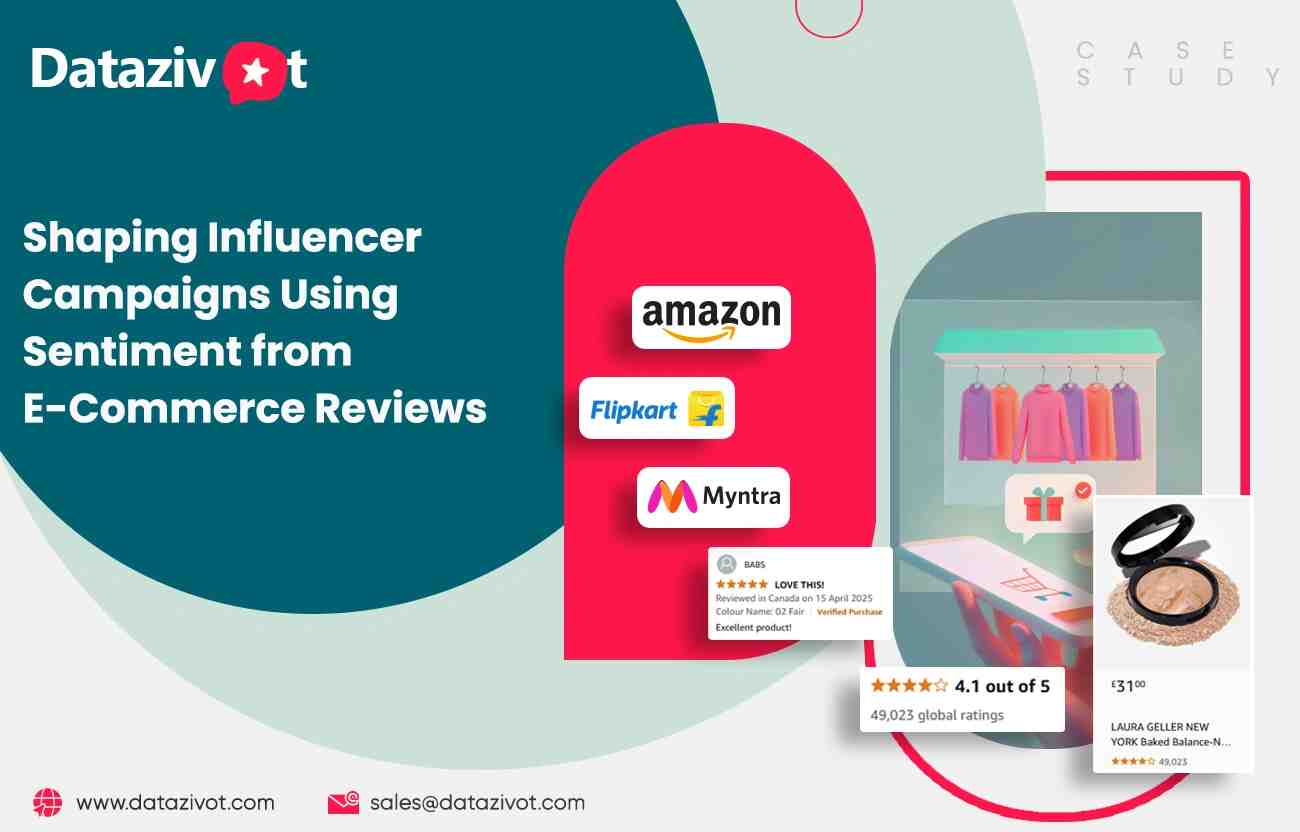
Business Challenge

A fast-scaling D2C beauty and fashion brand spent lakhs on influencer campaigns—but wasn’t getting expected ROI.
Their pain points:
- Influencer content was misaligned with what customers really valued.
- Negative reviews surfaced shortly after campaigns launched.
- Product features promoted by influencers often mismatched customer experience.
“We need to stop pushing talking points and start amplifying what real users actually say.”
The brand partnered with Datazivot for E-Commerce Reviews Scraping to analyze customer feedback from Amazon, Flipkart, and Myntra. The insights were used to craft a targeted, data-driven influencer strategy aligned with real consumer sentiments.
Objectives

- Extract real customer sentiment and top-praised product features.
- Identify key themes and phrases used in positive reviews.
- Craft influencer briefs using voice-of-customer insights.
- Flag potential product issues before campaign amplification.
- Track sentiment shifts before and after campaign drops.
Our Approach

1. Review Sentiment Mining
We scraped 100K+ reviews across:
- Amazon – Lipsticks, foundation, skincare combos
- Myntra – Dresses, tops, shoes
- Flipkart – Grooming kits, accessories
Captured:
- Product name, platform, rating
- Review text, timestamp
- Sentiment score
- Keywords and recurring themes
2. Review Language → Influencer Copy Mapping
From highly positive reviews, we extracted:
- Frequently used adjectives: “lightweight,” “non-sticky,” “perfect shade”
- Common benefits: “lasts all day,” “blends well,” “true to color”
- Emotional cues: “felt confident,” “finally found my shade”
These became the foundation for influencer talking points.
3. Issue Detection Before Campaigns
We ran sentiment alerts on target SKUs before campaign launch:
- Negative review volume
- Keywords tied to dissatisfaction
- Pre-launch return patterns
Campaigns were paused or messaging adjusted accordingly.
Sample Insights for Influencer Brief

Campaign Performance Boost

1. Higher Engagement & Authenticity
Influencers mirrored exact phrases from reviews:
- Feels weightless even in humidity”
- “Finally a kurta that fits perfectly from shoulder to waist”
Followers commented: “Same here!” / “That’s exactly what I thought!”
Result:
- Engagement up by 34%
- CTR improved 21%
- Return rate dropped 17% on featured SKUs
2. Pre-Launch Review Pulse Avoided Backlash
One serum had rising complaints (“smells weird,” “sticky texture”) on Amazon.
Sentiment score dropped to 59%.
Datazivot flagged it, and the influencer campaign was delayed.
Brand reformulated fragrance and relaunched 5 weeks later—positive sentiment rebounded to 80%.
Saved ₹5.2 lakh in potential influencer spend waste.
3. Localized Messaging from Review Regions
Using reviewer locations and language style:
- South India: Emphasized “no white cast” in sunscreen
- West India: Highlighted “festive look” in fashion apparel
- Hindi-speaking regions: Used translated phrases from positive reviews in reels
Regional influencer briefs matched review sentiment — improving local conversions by 26%.
Visual: Sentiment Summary Dashboard (Example)
.webp)
Stack Used
| Tool | Purpose |
|---|---|
| Scrapy, Selenium | Multi-platform review scraping |
| HuggingFace BERT | Sentiment tagging and phrase detection |
| spaCy | Keyword extraction, POS tagging |
| Google Looker | Dashboard and sentiment trend tracking |
| Slack Integration | Daily alerts to brand managers |
Impact Summary

- Influencer messaging 100% aligned with real user voice
- Campaign prep time cut by 30% via auto-generated review briefs
- Avoided ₹10L+ loss from misaligned influencer campaigns
- Boosted engagement, lowered returns, improved sentiment
Conclusion
Influencer campaigns shouldn’t be guesswork.
With Datazivot’s sentiment-backed content planning, brands tap into what real users already love—and avoid amplifying what they don’t.
Because the best influencer copy isn’t written in a meeting room. It’s already in your product reviews.
Source : https://www.datazivot.com/influencer-campaigns-sentiment-scrape-ecommerce-reviews-data.php

